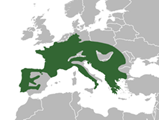Iberian salamander
Family
It belongs to the family Salamandridae, which includes several species of salamanders and newts.
Distribution and Habitat
The Iberian salamander is found in several regions of Europe, including the Iberian Peninsula, parts of France and some areas of Central Europe. They inhabit varied habitats, such as humid forests, mountainous areas, wooded areas and the banks of streams and brooks. They are usually associated with cool, damp places.
Behaviour
Iberian salamanders are nocturnal amphibians and tend to be active at night. During the day, they tend to hide in cool, damp shelters, such as under logs or stones. They are known for their smooth skin and distinctive colouration, which can range from black to yellow with black spots.
Feeding Habits
Iberian salamanders are carnivorous and feed on a variety of prey, including insects, spiders, worms and other invertebrates. They capture prey with their sticky tongue.
Reproduction
Reproduction of Iberian salamanders involves the laying of eggs in bodies of water, such as streams and temporary pools. After hatching, aquatic larvae develop and go through several stages before becoming adult salamanders. As they mature, they move to terrestrial habitats.
It is important to note that Iberian salamanders are sensitive to habitat loss and water pollution, so conservation of their habitats and protection of their environment are essential for their survival.



